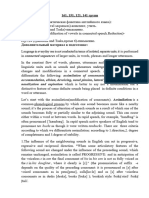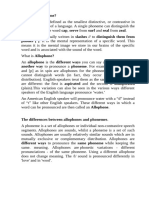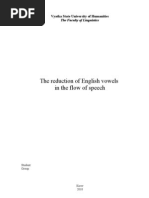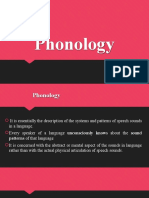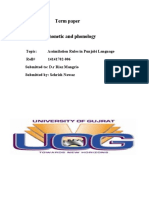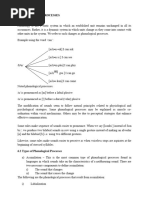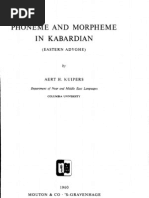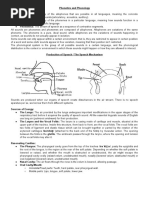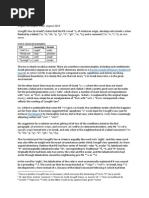Cap 12 Cruttenden
Cap 12 Cruttenden
Uploaded by
Lily Muñoz OrozcoCopyright:
Available Formats
Cap 12 Cruttenden
Cap 12 Cruttenden
Uploaded by
Lily Muñoz OrozcoCopyright
Available Formats
Share this document
Did you find this document useful?
Is this content inappropriate?
Copyright:
Available Formats
Cap 12 Cruttenden
Cap 12 Cruttenden
Uploaded by
Lily Muñoz OrozcoCopyright:
Available Formats
Cap.
12
Words in Connected Speech
12.1 Citation Forms and Connected Speech
Words as separable linguistic units are recognized in the sophisticated written form of English by the use of
spaces between words. Although in the continuous stream of speech there are no pauses between words
corresponding to such written spaces, words nevertheless show their independence by their ability to
stand alone, e.g. as replies to questions and when being referred to or cited. Differences often exist
between the pronunciation of words in their cited, isolate form and their pronunciation in connected
speech, when they are subject to influences from other, surrounding sounds and from larger accentual and
rhythmic patterns. The differences may concern the word as a whole, e.g. weak forms in an unaccented
situation; or they may concern a word's accentual pattern, e.g. loss or movement of an accent due to its
position in a larger accentual pattern; or they may involve the sounds used at word boundaries as in
assimilations, elisions and liaisons. This variation between Isolate forms and context-influenced forms
often depends on the casual or formal nature of speech, the more formal and careful (and probably
slower) the delivery, the greater the tendency to preserve a form nearer to that of the isolate word.
12.2 Neutralization of Weak Forms
We have seen already (11.3) that a number of function words may have different pronunciations when
they are accented (or said in isolation) and when, more typically, they are unaccented. Such is the
reduction in the unaccented forms that words which are distinct when said in isolation may be neutralized
when unaccented. Such neutralization generally causes no problem to listeners of the high rate of
redundancy of meaningful cues; only rarely does the context allow a variety of interpretations an
unaccented form. The examples of neutralization which follow might occur in casual (and usuali?) RP
1
.
/~/ = unaccented are, a (and, less commonly, her, or of)
The 'plays are `poor
He plays a `poor man
She `wants a dog
She wants her `dog (less rapidly, with reduced /3:/ for her)
`One or 'two of them are 'coming (or /O:/ for or, /~=/ for of)
`Two books are `mine
`Two `books of `mine (or, less rapidly, /~=/ for of)
/~=/ unaccented have (aux.), of
2
`Some of ,one piece...
`Some have ,won ...
The boys of Eton `fish
The boys have 'eaten 'fish
(The last two utterances being identical, the meaning is clear only from the larger context.)
1
Byrd (1992a) found women reducing less than men.
2
Native speakers often make written mistakes of the sort `I could of gone illustrating this neutralization.
/~t/ = unaccented are, or
`Ten or 'under (less rapidly, /O:/ for or)
`Ten are 'under
/A~/ = unaccented the, there
There 'seems a 'chance
The seams are 'crooked
/o/ unaccented is, has, does
`What's ('s = does or is) he like?
`What's ('s = has) he 'lost?
/,/ unaccented is, has, does
`Where's ('s = has, less commonly does) he 'put it?
`Wheres ('s = is) he 'going
/ ~,/ = unaccented as, has
'How much has he 'done?
As "much as he can
/~v/ = unaccented and, an
On and 'off
'On an 'off-chance
/v/ = unaccented and, not
Didn't/ he, do it? / oIov I: ou: It/
He 'did and he didn't / qI oIov I: oIovt/
/o/ = unaccented had, would
I'd ('d = had, would) 'put it 'here
12.3 Variation in the Accentual Patterns of Words
When a word (simple or compound) pattern in isolation of a primary accent preceded by a secondary
accent, the primary accent may be lost, if, in connected speech, a strong follows closely, e.g.
thir 'teen, but thirteen pounds
West 'minster, but Westminster 'Abbey
'full-'grown, but a 'full-grown 'man
`after 'noon, but afternoon 'tea
The secondary accent in the word rather than the primary may be lost when another word with secondary
accent immediately precedes, e.g.
eight thir'teen; 'near West minster; not full grown; Friday after'noon
Such examples, and the others in this section, confirm the tendency in English to avoid adjacent accented
syllables.
It is in order to avoid the placing of primary accents on adjacent syllables that 'accent shift' occurs in
phrases such as 'Chinese 'restaurant (but Chi `nese), `outside 'world (but out'side), 'aquamarine 'necklace
(but aquama'rine). Where the accents are separated by an unaccented syllable, the accent shift is optional,
e.g. diplo'matic, diplomatic 'incident or 'diplomatic 'incident; aquama`rine, aquama`rine ti'ara, 'aquamarine
ti`ara.
This tendency to the alternation of accented and unaccented syllables is so strong that the accent may be
shifted in the case of certain words whose form contains only one, later accent but where a full vowel
occurs in the preceding syllable, e.g. or'nate but 'ornate 'carvings; unique but 'unique 'features; and di`rect
but 'direct access. The alternation tendency extends into longer utterances and may be seen in examples
such as i`dea but The `idea pleases me; recom`mend but I can 'recommend 'several; and in phrasal verbs
such as 'come 'out, e.g. The 'pictures 'didn't come 'out, but They 'came out 'well and What 'time will 'you
get 'in? but 'What time will you 'get in from 'work?
12.4 Phonetic Variations within Words and at Boundaries
Our phonological units, the phonemes, represent abstractions from actual phonetic reality. If the phoneme
/t/ is given a convenient, generalized labela voiceless alveolar plosiveit is nevertheless true that the
actual phonetic realization of this consonant depends on the nature of the context, e.g. /t/ is aspirated
when before a vowel (except after /o/) as in [t
h
en]; it is dental, rather than alveolar, when adjacent to /A/
as in [eItT]. Besides these variations within words, such variation also occurs at word boundaries (and at
morpheme boundaries in compound and complex words) where tendencies towards co-articulation or
ASSIMILATION have to be noted.
Assimilations at boundaries, like those within words, may be merely of an allophonic kind; or they may be
of such an extent that a change of phoneme is involved, when comparing the pronunciation of a word in
isolation with its pronunciation in a particular context. Influence at word and morpheme boundaries
functions predominantly in a REGRESSIVE or ANTICIPATORY direction, i.e. features of one sound are
anticipated in the articulation of the preceding sound; less frequently it is PROGRESIVE or PERSEVERATIVE,
i.e. one sound influences the following sound, or it is COALESCENT, i.e. a fusion of forms takes place
12.4.1 Allophonic Variations
Since the actual realization of any phoneme is at least slightly different in every context, it is necessary to
give examples only of those variants which exhibit striking changes. The same types of allophonic variation,
involving a change of place of articulation' voicing', lip position or position of the soft palate, may be found
within the word and also at word boundaries:
(1) Place of articulation.
(a) within word:
/t/dental in eighth (influence of ([T])
/k/advanced (pre-velar) in key (influence of [[i:])
/v/dental in tenth (influence of [T])
//labiodental in nymph, infant (influence of [|])
//retracted in result (influence of ([K])
/u:/ fronted in music (influence of [|])
(b) at word boundaries:
/t/dental in not that (influence of [A])
/o/dental in hide them (influence of [A|)
// labiodental in ten forks, come for me (influence of [||)
(2) Voicedevoicing of continuants following a voiceless consonant
(a) within word:
/,,e,/devoiced following voiceless consonants, e.g _, tiqt, uuitc, uucuc
/,v,N/slightly devoiced following voiceless consonants, e.g. smoke snow, mutton, open /~Yt/, bacon
/'|cIkN/
(b) at word boundaries (only in close-knit sequences):
/l,r,w,J/devoiced following voiceless consonants, e.g. at last [~'tA:ot], at rest [~tcot|, at once
[~'tevo|, see to it ['oi:teIt|, thank you ['T{Nku:]
Note also the devoicing of word-final voiced plosive or fricative consonants before silence and of fricatives
when followed by a voiceless consonant; and of word-initial voiced fricative or plosive consonants when
preceded by silence, e.g. in What can you give? ([=]); Can you breathe? ([A|); It's his ([,]); near the bridge
([oZ|); They've ([=|) come; with ([A]) some; He's ([,|) seen it; George ([oZ|) can; ((=)) very good ([o]); ([A])
there; ([,]) Zinc does ([,]).
(3) Lip positionunder the influence of adjacent vowels or semivowels.
(a) within wonk
lip-spread lip-rounded
3
/t/ pea, heap pool, hoop, upward
/t/ tea, beat two, boot, twice, outward
/k/ keep, speak cool, spook, quite, backward
// mean, seem moon, loom, somewhat
/v/ knee, seen noon, onward
// leave, feel bloom, fool, always
//
4
read rude
/|/ feel, leaf fool, roof
/o/ seat, geese soon, goose, sweep
/E/ sheet, leash shoot, douche, dishwasher
3 This will apply only for those speakers who have appreciable rounding of the vowels and semivowels.
4 For some speakers // has inherent labialization and will not be lip-spread even before a lip-spread vowel.
/q/ he who, whom, hoot
(b) at word boundaries (only in close-knit sequences): e.g. /t, k, v, N, , o/ are somewhat labialized in such
eases as that one, thick one, thin one, wrong one, shall we, this way, when the syllables with initial /e/
carry no accent; a rounded vowel (as opposed to semivowel) in an adjacent word does not seem to exert
the same labializing influence, e.g. /u:/ does not labialize /o/ markedly in Who said that? Nor does /O:/ jn
this ought to.
(4) Nasal resonance
5
resulting particularly from regressive but also from progressive lowering of the soft
palate in the vicinity of a nasal consonant.
(a) within word: nasalization of vowel preceding // in ham and /v/ in and, of vowel between nasal
consonants in man, men, innermost and of short vowels on each side of the nasal consonant in any, sunny,
summer, singer, also //in such situations as in helmet, wrongly; and possible slight nasalization of vowel
following /,v/, as in meal, now.
(b) at word boundaries: vowels may sometimes be nasalized somewhat by the boundary nasal consonant
of an adjacent word, especially when an adjacent nasal consonant also occurs in the word containing the
vowel, e.g. the first /~/ in bring another, or /I/ in come in, but sometimes also with no adjacent nasal
consonant in the word containing the vowel (usually unaccented), e.g. /~/ in come along, wait for me, /I/ in
every night. Approximants may also be nasalized by a nasal in an adjacent word, e.g. // in tell me.
12.4.2 Phonemic Variations
Different phoneme selection within the same word may occur (either between two speakers or between
different styles of speech in the same speaker) depending on the degree of assimilatory pressure felt by
the speaker, e.g. length may be /cNT/, /cNKT/, or /cvT/, encounter may have /Iv/ or /IN/ in the first
syllable, disgrace may have final /o/ or /,/ in the first syllable, absolutely may have final /|/ or /t/ in the
first syllable and issue may have medial /sj/ or a coalesced form /E/. Historically a phonemic change within
a word can sometimes be due to assimilation to surrounding sounds, e.g. by labialization /eo(:)/ -> /eO/
or /eO:/ (swan, water); / I,c,Y/ coalesced into /~r/ (later /3:/) under the influence of the postvocalic
// (first, earth, curse); and /o/ or /, / and // combined their phonetic characteristics to give /E,Z
/ (mansion, vision).
Many phonemic changes occur in connected speech at word boundaries (i.e. change as compared with the
phonemic pattern of words' citation forms). Such phonemic variation is found in changes within the pairs
of voiced/voiceless Phonemes and, more particularly, in changes involving modification of the Place of
articulation.
12.4.3 Voiced/Voiceless Variations
Word-final fricatives followed by a word-initial voiceless consonant may Some speakers be realized as the
corresponding voiceless fricative, if the two words form part of a close-knit group. Thus the final /A/ of
with may be replaced by /T/ in with thanks; the final /,/ of was by /o/ in He was sent; and the final /=/ of
we've, by /|/ in of course, We've found it. Such a change to a voiceless fricative is an extension of the
allophonic devoicing of such consonants mentioned in 12.4.1 (2). The phonemic change in such examples
will be complete in that a preceding long vowel or diphthong will be realized in the reduced form
appropriate to a syllable closed by a voiceless consonant (see 8.4.1 (4)-(7), 9.2.1(5), 9.4 (4)).
The weak form of is or has is /o/ or /,/ according to the final consonant of the preceding word, cf. the cat's
paw, the cat's gone /k{to / vs the dog's paw, the dog`s gone /oO,/.
5
See Cohn (1990).
It is unusual in RP for word-final /|,o,/ to be influenced in the same way by following voiceless
consonants, though voiceless forms may be heard in such contexts in the speech of northern England, e.g.
the /o/ of good time and the // of big case may be realized as /t, k/.
It is to be noted that word- or morpheme-final voiceless consonants in English do not show assimilation to
their voiced counterparts: such pronunciations of nice boy, black dress, half-done, they both do, wishbone,
birthday, as /voI, |Ot, |{ oco, qA:= ov, Ac |~YA ou:, eIZ|~Yv, |3:AocI/ are
typical of many foreign learners.
12.4.4 Nasality and Labialization
Phonemic assimilations involving nasality (i.e. anticipation or perseveration of the lowered soft palate
position) would be likely to show /|/ (or /=/) -> //, /o/ (or /,/ or /A/) -> /v/, // -> /N/, such changes
being based on roughly homorganic mouth articulations; nasalization of other sounds, e.g. // or vowels, is
never phonemic, there being no nasalized counterpart with approximately homor ganic mouth
articulation. Such phonemic nasalization as does occur concerns mainly the alveolars, especially adjacent
to the negative n't /n(t)/ and is characteristic of very rapid speech, often as a popular form unacceptable in
RP (marked in the examples below), e.g.
/o/ > /v/He wouldn't do it /qI eYvv(t) ou: It/ good news /Yv vEu:,/ (Sussan, no s si va la
letra E o la no me doy cuenta)
/o/ > //> /N/He wouldn't go /qI eYvv(k) ~Y/
/o/ >/|/> /m/Good morning /Y O:viN/
/=/ > //You can have mine /Y kN q{ oIv/
/,/ > /v/He doesn't know /qI ovv(t) v~Y/
/A/> /v/He wasn't there /qI eOv(t) vc~/
to win the race /t~ eiv v~ cio/
(In the above examples, the nasalized assimilated form may be elided altogether)
The extension of labialization produces no changes of a phonemic kind, since lip-position is not a distinctive
feature opposing any two phonemes in RP. /O/and /A:/ come nearest to having an opposition of lip action,
but the lip-rounding for /O/ is very slight and open and, in any case, there is some difference of tongue
position and a considerable difference of length. Where /e/ precedes a vowel of the /A:/ type (and,
therefore, might be expected to exert a rounding influence), either labialization has become established at
an earlier stage of the development of the language (e.g. in was, what, war, water, etc.) or two
pronunciations are today permitted, e.g. qualm /keA:/ or /keO:/, quaff /keO|/ or /keA:|/.
Labialization of /A:/ involving a phonemic change to /O/ or /O:/ does not extend beyond word boundaries,
e.g. in two arms or The car won't go. Some confusion may, however, occur between a strongly centralized
form of /~Y/ and /3:/ in a labial context, cf. They werent wanted and They wont it; also, with the
influence of a strongly labialized form of // in such a pair as They weren`t right, They wont write.
12.4.5 Variations of Place
The most common phonemic changes at word boundaries concern changes of place of articulation,
particularly involving de-alveolarization. Though such changes are normal in colloquial speech, native
speakers are usually unaware that they are made. The phenomenon is essentially the same as that
resulting in non-phonemic assimilation of place. Electropalatographlc research
6
shows that phonemic
6
See Nolan and Kerswill (1990). They also found girls less likely to assimilate tan boys and /v/ more likely to assimilate than /o/.
assimilations of place are rarely complete, e.g. in an assimilation involving an apparent change from
alveolar to labial, as in bad boy -> /|{| |OI/, some residual articulation on the teeth ridge may accompany
the labial articulation. (See 9.2.6 (2), 9.6.2 (2).)
(1) Regressive (or anticipatory) assimilation: instability of final alveolars
Word-final /t,o,v,o,,/ readily assimilate to the place of the following word-initial consonant while retaining
the original voicing. /t,o,v/ are replaced by bilabials before bilabial consonants and by velars before velar
consonants; /o,,/ are replaced by palato-alveolars before consonants containing a palatal feature:
7
/t/ > /t/ before /t,|,/, e.g. that pen, that boy, that man /A{t 'tcv, A{t '|OI, A{t '{v/
>/k/ before /k,/, e.g. that cup, that girl /A{k/ 'kt, A{k '3:/
/o/ > /|/ before /t,|,/, e.g. good pen, good boy, good man /Y| 'tcv, Y| '|OI, Y| '{v/
> /g/ before /k,/, e.g. good concert, good girl /u 'kOvo~t, Y '3:/
/v/ > // before /t,|,/, e.g. ten players, ten boys, ten men /tc 'tcI~,, tem '|OI,, tc 'cv/
/v/ > /N/ before /k,/, ten cups, ten girls /tcN 'kto, tcN '3:,/
(As a result of word-final assimilations, /N/ may be preceded by vowels other than /Ic{O/ Thus /N/ can
occur after long vowels as a result of assimilation, e.g. I've /|i:/ gardening, She'll soon /ou:N/ come, his
own /~u/ car, etc.).
Assimilations to alveolars and between labials and velars are generally felt to be substandard in RP,
although they may sometimes be heard in fast speech, e.g. same night/ocIv 'voIt/, king Charles /kIv
'tEA:,/, same kind /ocIv 'koIvo/, blackmail /'|{tcI/.
/o/ > /E/
8
before /E, tE, oZ, /, e.g. this shop, cross Channel, this judge, this year
/AIE EOt, kOE tE{v~. AIE oZoZ, AIE t~/.
/,/ > /Z/ before /E, tZ, oZ, / , e.g. those young men /A~YZ N cv/, cheese shop /tEi:Z EOt/,
those churches /A~YZ tE3:tEI,/ has she? /q{ZEI/ or /q{E EI/.
Other assimilations involving fricatives are generally felt to be substandard in RP, although /T,A/ may
assimilate to is, /o, ,/ in fast speech, e.g. I loathe singing /oI ~Y, oININ/, Whats the time?
/eOto ,~ toI/, Has the post come? /q{, ,~, t~Yo k/.
Alveolars have a high frequency of occurrence in word-final position, especially when inflexional and so
their assimilation leads to many neutralizations in connected speech, e.g. /{N keIkI/ (ran or rang
quickly), /oIt tc~,/ (right or ripe pears or pairs), /oIk ki:/ (like or light cream), /qOt ~vY~/
(hot or hop manure), /t{IE E~Y/ (Paris Show or parish show), /eOtE EO: ecIt/ (Whats or Watch
your eight),
9
or, with a neutralization to a labiodental articulation, /cIt =o/ (great or grape vine),
[u |~ O: vI| (run or rum for your money).
7
See also 12.7 for stylistic variation in the frequency of assimilation.
8
Byrd (1992b) found around 78% of sequences of /o,,/ plus /E/ reduced to a palato alveolar articulation only (in the TIMIT
database of American English), with no effect from syntax, sex or dialect.
9
In the utterance is reduced to /eOtEO: ecIt/, there is also the possibility of the interpretation watch or wait.
When alveolar consonants /t, o, v/ are adjacent in clusters or sequences susceptible to assimilation, all (or
none) of them will undergo the assimilation, e.g. Don't /o~Yt/ be late, He won't /e~YNk/ come, I didn't
/oINk/ go, He found /|oY|/ both, a kind /koIN/ gift, red and black /c| |{k/.
(2) Coalescence of /t, o, o, ,/ //
The process which has led historically to earlier /t, o, o, ,/ + // giving /tE, oZ, E, Z/ medially in a word
(nature, grandeur, mission, vision9.3.1) may operate in contemporary colloquial speech at word
boundaries, e.g.
/t/ + //what you want /eOtEu: eOvt/
/o/ + //Would you? /eYoZu:/
/o/ + //in case you need it /IN kcIEu: vi:o It/
/,/ + //Has your letter come? /q{ZO: ct~ k/, as yet /~Zct/
The coalescence is more complete in the case of /t,o/ + // (especially in question tags, e.g. didn't you?,
could you?, etc.); in the case of /o,,/ + //, the coalescence into /E,Z/ may be marked by extra length of
friction, e.g. Don't miss your train /o~Yt IEEO: tcIv/.
In very careful speech, some RP speakers may use somewhat artificial, uncoalesced, forms within words in
words like nature, question, unfortunate, soldier /vcIt~, kecot~v, v |O:tYv~t, o~Yo~/.
Such speakers will also avoid coalescences at word boundaries; yet other careful speakers, who use the
normal coalesced forms within words, may consciously avoid them at word boundaries. (See 12.7 below.)
(3) Progressive (or perseverative) assimilation is relatively uncommon. It may occur when a plosive is
followed by a syllabic nasal and the nasal undergoes assimilation to the same place of articulation as the
preceding plosive, e.g. /v/ > // after /t,|/, happen, urban /q{t, 3:|/; and /v/ > /N/ after /k,/
in second chance, organ as /ockN tEo:vo, O:N/.
12.4.6 Elision
Apart from word-internal elisions (see 10.8) and those associated with weak forms, sounds may be elided
in fast colloquial speech, especially at or in the vicinity of word boundaries.
(1) Vowels (a) Allophonic variationWhen one syllable ends with a closing diphthong (i.e. one whose
second element is closer than its first, in RP, /cI,oI,OI,~Y,oY/) and the next syllabic begins with a vowel,
the second element of the diphthong may be elided. Word-internal examples of the type discussed in
8.11 (e.g. hyaena /qoIi:v~/ smoothed to [qoi:v~]) may result in neutralization, thus layer /cI~e/
with smoothing is the same as lair /c~/, mower /~Y~/ with smoothing is the same as myrrh /3:/.
Similar smoothing occurs across word boundaries, e.g. go away /3: ecI/, I may as well /oI c~, ec/, I
enjoy it /oI Iv oZO It/, try again [to ~cv] or [to: cv].
(b) Phonemic elisionInitial /~/ is often elided particularly when followed by a continuant and preceded
by a word-final consonant (compensation for the loss of /~/ frequently being made by the syllabicity of the
continuant), e.g. not alone [nOt ~Yv=|, get another [ct vA~|, run along [v ON|, he was annoyed
[qI e~, vOIo]; or again, when final /~/ occurs with following linking // (see 12.4.7) and word-initial
vowel, /~/ of may be elided, e.g. after a while /A:|t~ eoI/, as a matter of fact /~, ~ {t~= |{kt/,
father and son /|A:A4~v ov/, over and above /~Y=~v ~|=/
(2) Consonants In addition to the loss of /q/ in pronominal weak forms and other consonantal elisions
typical of weak forms (see 11.3), the alveolar plosives are apt to be elided. Such elision appears to take
place most readily when /t/ or /o/ is the middle one of three consonants. Any consonant may appear in
third position, though elision of the alveolar plosive is relatively rare before /q/ and //. Thus elision is
common in the sequence voiceless continuant + /t/ or voiced continuant + /t/ or voiced continuant + /o/
(e.g. /ot, |t, Et, vo, o, ,o, Ao, =o/) followed by a word with an initial consonant,
10
e.g. next
day, raced back, last chance, first light, west region, just one; left turn, soft centres, left wheel, drift by, soft
roes; mashed potatoes finished now, finished lute, pushed them; bend back, tinned meat, lend-lease,
found five, send round, dined well; hold tight, old man, cold lunch, bold face, world religion; refused both,
gazed past, caused losses, raised gently; loathed beer; moved back, loved flowers, saved runs, served
sherry. Similarly, word-final clusters of voiceless plosive or, affricate + /t/ or voiced plosive or affricate +
/o/ (e.g. /tt, kt, tEt, |o, uo, oZo/) may lose the final alveolar stop when the following word has an
initial consonant, e.g. kept quiet, helped me, stopped speaking, jumped well; liked jam, thanked me,
looked like, looked fine, picked one; reached Paris, fetched me, reached Rome, parched throat; robbed
both, rubbed gently, grabbed them; lugged behind, dragged down, begged one; changed colour, urged
them, arranged roses, judged fairly. (In the sequence /-okt/ /k/rather than /t/ is often elided, e.g. risked
prison, asked them.) The final clusters /vt,t/, which are the only alveolar sequences which involve a
change of voicing, are less prone to elision, the /t/ often remaining as [?] e.g. went down.
Elision of final /t/ or /o/ is rarer before initial /q/. e.g. the alveolar stops axe more regularly retained in
kept hold, worked hard, East Ham, reached home, gift horse, rushed home, grabbed hold, round here, bald
head, jugged hare, changed horses raised hands, moved house. Final /t,o/ followed by a word beginning
with // are usually kept in a coalesced form, i.e. as /tE/ and /oZ/, e.g. helped you, liked you, lost you, left
you, grabbed you, lend you, told you, etc.
It will be seen that in many cases, e.g. in I walked back, They seemed glad, elision of word-final /t/ or /o/
eliminates the phonetic cue to past tense, compensation for which is made by the general context. Such is
the instability of the alveolar plosives in such a position of apparent inflexional significance that it can be
assumed that the context regularly carries the burden of tense distinction. Where the juxtaposition of
words brings together a cluster of consonants (particularly of stops), elision of a plosive medial in three or
more is to be expected, since, because of the normal lack of release of a stop in such a situation, the only
cue to its presence is likely to be the total duration of closure.
The /t/ of the negative /vt/ is often elided, particularly in dissyllables, before a following consonant, e.g.
You mustn't lose if/Y ov u:, It/. Doesn't she know? /o,v EI v~Y/, and sometimes before a
vowel, e.g. Wouldn't he come? /eYov i: k/, You mustn't over-eat /jY ov ~u=~ i:t/. Less
common is the omission of the stops in the negative /vt/ component of monosyllables, e.g. He wont do
it /qI e~Yv ou: It/.
Clusters of word-final /t/ and word-initial /t/ or /d/ are sometimes simplified Informal speech, e.g. I've got
to go /oI= Ot~ ~Y/, What do you want? /eOo~ u: eOvt/ or /eOoZu: eOvt/, and less
commonly /o/ before /t/ or /o/, e.g. We could try /eI kY toI/, They should do it /AcI E~ ou: It/.
The elision of one of a boundary cluster of only two consonants sometimes occurs in casual speech, but is
usually characterized as substandard, e.g. He went away /qI ecv ~ecI/, want to come /oI eOv~ k/
(< < /oI eOvt~ k/, ei_q |cuucvt o__uo), Give me a cake /I I ~ kcIk/, Let me come in
/cI k Iv/, Get me some paper /cI o tcIt~/, oo ec as the very reduced forms of Im going to
/oI ~v~, oIN~v~, oINv~/. The /=/ in of can be elided in casual speech before a consonant, e.g. a
piece of cake /~ ti:o ~ kcIk/. Clusters in adverbs formed with ly are also liable to reduction in rapid
and/or casual speech, e.g. stupidly /otu:tII/, openly /otu:tII/ otcv /~Yt~vI/.
12.4.7 Liaison
10
Deterding (2205) in a study of newsreaders on the BBC World Service found deletion common in both suffix and stem-final
/t,o/ and most common before initial plosives, fricatives and nasals.
(1) Linking //. As has been mentioned in 9.7 (2) (a), RP introduces word-final post-vocalic // as a linking
form when the following word begins with a vowel. The vowel endings to which an // link may be added
are /A:,O:/ and those single The vowels containing final [~] (/~,3:,I~,c~,Y~/), e.g. in far off, four aces,
answer it, fur inside, near it, out, secure everything. Prescriptivists seek to limit the allowabllity of linking
// to those cases where there is an // in the spelling; nevertheless many examples of linking // occur
where there is no // in the spelling, such //s being labelled as 'intrusive'. Such //'s are to be heard
particularly in the case of /~/ endings, e.g. Russia and China /IE~ ~v tEoIv~/, drama and music
/oA:~ ~ u:,Ik/, idea of /oI oI~ ~=/, India and Pakistan /IvoI~ ~v tA:kIotA:v/, area of
agreement /c~I~ ~= ~i:~vt/; and rather less frequently after final /A:VV,O:V/ e.g. law and order
/O: ~vo O:o~/, awe-inspiring /O: IvotoI~IN/, raw onion /O: v~v/. Spelling consciousness
remains an inhibiting factor in the use of linking //, but the present general tendency among RP speakers
is to use // links, evenunconsciouslyamong those who object most strongly.
11
The comparative rarity
of potential contexts for 'intrusive' //'s following /A:,O:/ tends to make speakers more aware of the
'correct' forms; thus I saw it /oI oO: It/, drawing, /oO:IN/, are generally disapproved of, though
those who avoid such pronunciations have to make a conscious effort to do so. The focusing of attention
on 'intrusive' //'s as an undesirable speech habit has led to the use by some speakers of a pause or glottal
stop in such cases of vowel hiatus, with the result that, in avoiding 'intrusive' //'s, they have also
abandoned other linking //s in favour of a glottal stop or a glide between the abutting vowels, e.g. in
secure it [oi:kY~ ?It], War and Peace [eO: ?~vo ti:o|. As might be expected, in those regions where
post-vocalic // is pronounced and pour, paw are identified as separate word forms in isolation, the
tendency to Introduce Intrusive //s is less marked than in RP or in RP-influenced types of speech.
The same process is in operation whether the // link inserted is historically justified (linking) or not
(intrusive). The examples below demonstrate that the environment is phonetically comparable whether
the // link is inserted before a suffix or before a separate word and whether it Is linking or 'intrusive'
stir stirring stir it in
/ot3: ot3:IN ot3: It iv/
dear dearer my dear Anna idea of it
/oI~ oI~~ oI oI~ {v~ oI oI~ ~= It/
roar roaring roar angrily raw egg strawy
/O: O:IN O: {N~I O: c otO:I/
star starry a star in the sky the spa at Bath schwaish
/otA: otA:I ~ otA: Iv A~ okoI A~ otA: ~t |A:T EeA:IE/
There appears, however, to be some graduation in the likelihood of occurrence as follows:
(a) The insertion of // is obligatory before a suffix beginning with a where the//is historically justified.
(b) The insertion of // is optional, though generally present, before a following word beginning with a
vowel, where the // is historically justified.
(c) After [~|, even an intrusive // (i.e. historically unjustified) is generally used before a following word,
e.g. vanilla essence /=~vI~ co~vo/, vodka and tonic /=Ook~ ~v tOvIk/.
11
Intrusive /t/ is decreted as a vice as early as Sheridan (1762)-
(d) After /A:/ and /O:/, an intrusive // is often avoided before a following vowel, e.g. nougat and
chocolate /vu:A: ~v tEOkIt/, straw in the wind /strO: Iv A~ eIvo/.
(e) The insertion of intrusive // before a suffix is often strongly stigmatized, e.g. strawy /otOI/,
gnawing /vO:IN/.
Phonetically (as well as historically) the resulting // closes the syllabic rather than being initial in the next,
e.g. the // of more ice /O: oIo/ is shorter than that of more rice /O: oIo/, the latter also being
associated with accent onset and possible pitch change (cf. 12.4.8).
(2) Linking [,
|
] in vocalic junctures where the first word ends in /I:/, /I/ /cI/, /oI/, or /OI/, a slight linking
[] may be heard between the two vowels, e.g. my arms [oI A:,|, may ask [oI A:ok|, he ought
|hi: 'b:t], annoy Arthur [arui beauty and (bju:ti: ^ond). But this is not sufficient to be equated with
phonemic Ijl; indeed there are minimal pairs which illustrate the difference between linking [J] and
phonemic Ijl, my ears (mai 'Jiaz| vs my years [mai 'Jiaz], and I earn [ai M3:nl vs / yearn [at 'JarnJ. Similarly a
linking D may be heard between a final /u:/, /ou/ and /au/ and a following vowel, e.g. window open
(windao 'waupanJ, now end then |nau wond en+, you aren't |ju: %wo:nt); and minimal pairs illustrating
linking n and phonemic /w/ can be found, e.g. twv-eyed *tu: 'waid| vs too wide *tu: wajdJ. Alternative
pronunciations, more frequent in faster speech, in the case of the sequences of diphthong plus following
vowel, involve the absorption of jh* second element of the diphthong, i.e. of the [i] in the case of /ei,ai,3i/
anc* *
[uj in the case of /au.au/, giving renderings like <nmoy Arthur [aiv> 'a:a] n*y<a [ma 'tazj, window open
['windaaupan] (see further under 8.11 (8) above).
In yet another possibility, the linking I1) or ["] may be replaced by a &10 stop. This is most common before
a vowel beginning an accented syllab e, ^ very angry *ven 7aeggri| (see further 9.2.8). However, glottal
stop In such not so often used as in some other languages, e.g. German, and is usually ated in English with
some degree of emphasis. cdov#
(3) Other boundaries. It is unusual for a word-final consonant to be carn^v0ljj as initial in a word
beginning with an accented vowel, the Identity of t1 .n>f, being retained (see 12.4.8). Thus, nm off, give
In, less often are iarcly ,tatjpn, gi'vin, le5ofn/ (shown because the nuclear tone, usually high fall m
does not begin on the consonant); and get up, look out, stop arguing, are n. at|on ally |ge *thAp, lu 'khaut,
stn pha:gjunjl (the plosives lacking the strong asP' characteristic of an accented syllable-initial position).
One or two ph
You might also like
- Assimilation and ElisionDocument2 pagesAssimilation and ElisionRashed Bin Monsur100% (3)
- Indians Salish Folktales of The Coast SalishDocument295 pagesIndians Salish Folktales of The Coast SalishSwordAce100% (2)
- Assimilation: Is A Process of Alteration of Speech Sounds As A Result of WhichDocument16 pagesAssimilation: Is A Process of Alteration of Speech Sounds As A Result of Whichapi-283816739No ratings yet
- Syllabic ConsonantsDocument6 pagesSyllabic Consonantsrody.rodina36No ratings yet
- Завдання для самостійної роботи з Фонетики 1 курсDocument4 pagesЗавдання для самостійної роботи з Фонетики 1 курсIvanka ShumykNo ratings yet
- Features of Connected SpeechDocument30 pagesFeatures of Connected SpeechJoselyn Wrande Sanhueza100% (2)
- 4short NotesDocument4 pages4short Notesrody.rodina36No ratings yet
- Aspects of Connected SpeechDocument7 pagesAspects of Connected SpeechSaMa DCh100% (1)
- UNIT 7 PhoneticsDocument8 pagesUNIT 7 Phoneticsmjgvalcarce7105100% (1)
- Syllabic Structure of English WordsDocument118 pagesSyllabic Structure of English WordsКатерина ПарийNo ratings yet
- Syllable, Word Stress, WV, Neutralized Vowels, ElisionDocument29 pagesSyllable, Word Stress, WV, Neutralized Vowels, ElisionGaby Micaela RuizNo ratings yet
- CONSONANTSDocument6 pagesCONSONANTSnadia nur ainiNo ratings yet
- Connected SpeechDocument12 pagesConnected SpeechNey Ney Alba100% (2)
- Unit 5. Segmental and Suprasegmental ElementsDocument6 pagesUnit 5. Segmental and Suprasegmental Elementsines regueiraNo ratings yet
- 1627927007.connected Speech and CoarticulationDocument12 pages1627927007.connected Speech and CoarticulationAyelen LópezNo ratings yet
- Connected Speech Phenomena 5Document1 pageConnected Speech Phenomena 5MirnaNo ratings yet
- A Vowel Digraph: Is Two Letters With The First Letter Making A Long Sound and The Second Letter Is Silent. We Call ThisDocument6 pagesA Vowel Digraph: Is Two Letters With The First Letter Making A Long Sound and The Second Letter Is Silent. We Call ThisErica EllenNo ratings yet
- PhonologyDocument31 pagesPhonologyyokaj18372No ratings yet
- Vowel ReductionDocument6 pagesVowel Reductiononabas12100% (1)
- Introduction To VowelsDocument6 pagesIntroduction To VowelsAshtrith NietoNo ratings yet
- EPP - Rhythm and AssimilationDocument14 pagesEPP - Rhythm and AssimilationVirdha DhewiNo ratings yet
- Weakstrong Syllables 1225480882591451 9Document31 pagesWeakstrong Syllables 1225480882591451 9Jesus Muñante CassanoNo ratings yet
- Accentual PatternDocument17 pagesAccentual PatternArchana MadpathiNo ratings yet
- Small SyllablesDocument6 pagesSmall SyllablesThảo HoàngNo ratings yet
- Sound Interchange in Modern Colloquial Speech: T. A. Brovchenko, O. Alexandrova, A. MalihinaDocument7 pagesSound Interchange in Modern Colloquial Speech: T. A. Brovchenko, O. Alexandrova, A. MalihinaTrần Minh KiênNo ratings yet
- PHONOLOGICAL-RULES-1Document21 pagesPHONOLOGICAL-RULES-1kay93340No ratings yet
- Features of Connected SpeechDocument6 pagesFeatures of Connected Speechdenieb1311No ratings yet
- Phonology - IntroductionDocument13 pagesPhonology - IntroductionDiego Martiez barreiroNo ratings yet
- 6 ФОНЕТИКАDocument7 pages6 ФОНЕТИКАВиктория ДмитренкоNo ratings yet
- Dr. Riceli C. Mendoza University of Southern Mindanao PhilippinesDocument17 pagesDr. Riceli C. Mendoza University of Southern Mindanao PhilippinesJose Luis Gatillon SotoNo ratings yet
- Phonological RulesDocument5 pagesPhonological RulesJasmin Cadir100% (1)
- Sumary U-4 PhonologyDocument9 pagesSumary U-4 Phonologyv2mgmsd6ghNo ratings yet
- Independent WorkDocument5 pagesIndependent WorkZhania NurbekovaNo ratings yet
- ORAL II - ALLPHONES - CONSONANTS and VOWELSDocument36 pagesORAL II - ALLPHONES - CONSONANTS and VOWELSMaría M MalakNo ratings yet
- ELS 55 Reviewer (Phonology)Document20 pagesELS 55 Reviewer (Phonology)buyantemaryandreaNo ratings yet
- TSLB3043 Week 11practice in Spoken DiscourseDocument15 pagesTSLB3043 Week 11practice in Spoken DiscourseEllishNo ratings yet
- Phonetics_240128_211952Document17 pagesPhonetics_240128_211952Bianca NavarroNo ratings yet
- Phonetics_HW2Document3 pagesPhonetics_HW2guillaumelabbe6No ratings yet
- 1) 1 Indeed, There Are Minimal Pairs Which ¡Ilústrate The Difference Between LinkingDocument1 page1) 1 Indeed, There Are Minimal Pairs Which ¡Ilústrate The Difference Between LinkingCristian GuerraNo ratings yet
- Syllable, Word Stress, WV, Neutralized Vowels, ElisionDocument33 pagesSyllable, Word Stress, WV, Neutralized Vowels, ElisionJuan AbdalaNo ratings yet
- Connected SpeechDocument7 pagesConnected SpeechMaria Eugenia Glosnicki100% (1)
- Allophones 2021Document14 pagesAllophones 2021fidelromantabordaNo ratings yet
- Meeting 6: Distinctive Features, Phonotactic Rules, and Consonant ClustersDocument10 pagesMeeting 6: Distinctive Features, Phonotactic Rules, and Consonant ClustersRia Oktaviani100% (1)
- Variation in Point of ArticulationDocument4 pagesVariation in Point of ArticulationEduardo GonzálezNo ratings yet
- Lecture 5 PhonologyDocument20 pagesLecture 5 PhonologyFrinzess VelascoNo ratings yet
- 1 Connected SpeechDocument21 pages1 Connected SpeechdiwiyanaNo ratings yet
- Theory of PhonemesDocument41 pagesTheory of Phonemesda817151No ratings yet
- Connected SpeechDocument66 pagesConnected Speechandrewcook33332100% (1)
- PhoneticDocument7 pagesPhoneticDress CodeNo ratings yet
- UntitledDocument6 pagesUntitledAnna-Marie DroščínováNo ratings yet
- Vowels Introduction Paul CarleyDocument15 pagesVowels Introduction Paul CarleyMarshall LuuNo ratings yet
- Typology: Linguistics Syllables Suprasegmental PhonemicDocument6 pagesTypology: Linguistics Syllables Suprasegmental PhonemicHanie Balmedina-RazoNo ratings yet
- Articulation - Vowels and ConsonantsDocument2 pagesArticulation - Vowels and ConsonantsMahfoodh AljubouryNo ratings yet
- The Distinctive CompositionDocument5 pagesThe Distinctive Compositionsofija manaievaNo ratings yet
- The SyllablesDocument7 pagesThe SyllablesOey BiNo ratings yet
- Lesson 3 English Transcription CourseDocument15 pagesLesson 3 English Transcription CourseLily Muñoz OrozcoNo ratings yet
- Aula 4Document13 pagesAula 4MarlisonNo ratings yet
- General Characteristics of Phonemes, Pak NDocument10 pagesGeneral Characteristics of Phonemes, Pak NНаталия ПакNo ratings yet
- The Pronunciation of English: A Reference and Practice BookFrom EverandThe Pronunciation of English: A Reference and Practice BookRating: 5 out of 5 stars5/5 (1)
- Webster's American English Dictionary (with pronunciation guides): With over 50,000 references (US English)From EverandWebster's American English Dictionary (with pronunciation guides): With over 50,000 references (US English)Alice GrandisonNo ratings yet
- Knittax Knitking Pattern Reader InstructionsDocument14 pagesKnittax Knitking Pattern Reader InstructionsLily Muñoz Orozco0% (1)
- Refining Composition Skills CorregidoDocument35 pagesRefining Composition Skills CorregidoLily Muñoz OrozcoNo ratings yet
- El Arte de Tejer 2010Document25 pagesEl Arte de Tejer 2010Lily Muñoz OrozcoNo ratings yet
- Gimson's Pronunciation of English CorregidoDocument3 pagesGimson's Pronunciation of English CorregidoLily Muñoz OrozcoNo ratings yet
- Lesson 3 English Transcription CourseDocument15 pagesLesson 3 English Transcription CourseLily Muñoz OrozcoNo ratings yet
- Cruttenden Chapter 8Document42 pagesCruttenden Chapter 8Lily Muñoz OrozcoNo ratings yet
- Chapter 2 Phrasal VerbsDocument4 pagesChapter 2 Phrasal VerbsLily Muñoz OrozcoNo ratings yet
- Spanish Phonology PDFDocument15 pagesSpanish Phonology PDFT of Eng100% (1)
- British English (KW), (K), and (W) Distinction in Back Round Vowel ContextsDocument5 pagesBritish English (KW), (K), and (W) Distinction in Back Round Vowel ContextsPere MollàNo ratings yet
- Phonological ProcessDocument11 pagesPhonological ProcessYunda Ravirgo100% (1)
- Secondary and Double Articulation: April 2011Document18 pagesSecondary and Double Articulation: April 2011Point KillesNo ratings yet
- Weh PhonologyDocument36 pagesWeh PhonologyRice BuoiNo ratings yet
- Assimilation RulesDocument13 pagesAssimilation RuleshafidNo ratings yet
- Cap 12 CruttendenDocument11 pagesCap 12 CruttendenLily Muñoz OrozcoNo ratings yet
- Assimilation of Segments in Modern Standard Arabic Schane's (1973) Views On Generative PhonologyDocument24 pagesAssimilation of Segments in Modern Standard Arabic Schane's (1973) Views On Generative PhonologyTaha TmaNo ratings yet
- Phonological Rules and Processes: An IntroductionDocument14 pagesPhonological Rules and Processes: An IntroductionAcademic JournalNo ratings yet
- (Phonetics and Phonology) Session 6: I. Weak Forms II. Aspects of Connected SpeechDocument24 pages(Phonetics and Phonology) Session 6: I. Weak Forms II. Aspects of Connected SpeechĐặng Lê Khánh LinhNo ratings yet
- Secondary Articulations: Further DemosDocument7 pagesSecondary Articulations: Further DemosAnkita DasNo ratings yet
- My ResearchDocument31 pagesMy ResearchHaider KhanNo ratings yet
- The Representation of Features and Relations: in Non-Linear PhonologyDocument322 pagesThe Representation of Features and Relations: in Non-Linear PhonologyFares RababaNo ratings yet
- Vandenhoeck & Ruprecht (GMBH & Co. KG)Document30 pagesVandenhoeck & Ruprecht (GMBH & Co. KG)MPTScribidNo ratings yet
- IPA (International Phonetic Alphabet)Document26 pagesIPA (International Phonetic Alphabet)M HAFIDZ RAMADHAN RAMADHANNo ratings yet
- The Rules Governing The Writing-Pronunciation Contrast in Urdu: A Phonological StudyDocument8 pagesThe Rules Governing The Writing-Pronunciation Contrast in Urdu: A Phonological StudynasimbanoNo ratings yet
- ASSIMILATIONDocument31 pagesASSIMILATIONHaider KhanNo ratings yet
- Phonological Processes 1Document3 pagesPhonological Processes 1oserobritonNo ratings yet
- A Kuipers Phoneme and Morpheme in Kabardian 1960Document121 pagesA Kuipers Phoneme and Morpheme in Kabardian 1960jarubirubiNo ratings yet
- Fonética y Fonología IDocument18 pagesFonética y Fonología IAC100% (1)
- Eng Asgnmnt For SeminarDocument26 pagesEng Asgnmnt For SeminarWaive Rita100% (1)
- Connected SpeechDocument6 pagesConnected SpeechValentina CandurinNo ratings yet
- IPA Pronunciation GuideDocument20 pagesIPA Pronunciation GuideF_Community100% (1)
- Velarization - Mohammed MasoudDocument6 pagesVelarization - Mohammed MasoudMohammed MasoudNo ratings yet
- BAJOLIN (2020) Language Documentation-A Phonemic Analysis of FakkanciDocument20 pagesBAJOLIN (2020) Language Documentation-A Phonemic Analysis of FakkanciOldmanNo ratings yet
- The Phonetic Structures of Kalanguya (University of The Philippines, Diliman Undergraduate Thesis, 2010)Document11 pagesThe Phonetic Structures of Kalanguya (University of The Philippines, Diliman Undergraduate Thesis, 2010)Paul Julian Santiago100% (1)
- 0715 CB 035Document74 pages0715 CB 035RAyn FrAqaNo ratings yet
- Ekpeye DictionaryDocument43 pagesEkpeye DictionaryJohnwyseNo ratings yet
- Cowgill's LawDocument2 pagesCowgill's Lawmiguelcv58No ratings yet




